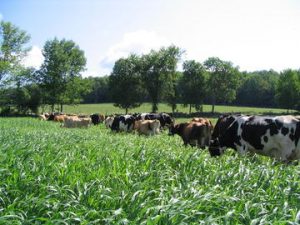Small- to mid-sized Northeast dairy farmers face increasingly challenging constraints from a limited labor supply, extreme weather events and steadily rising feed prices. As a result, farmers need a flexible, more resilient system where they can grow their own high-quality dairy forage in corn- and alfalfa-based cropping systems.Dairy cows grazing on brown midrib sorghum sudangrass (BMR SS)
A new SARE fact sheet, Alternative Continuous-Cover Dairy Forage System for Profitability, Flexibility and Soil Health, describes such a system. One farmer increased net income $531 per acre after implementing the alternative continuous-cover forage (ACCF) system in collaboration with Cornell University Cooperative Extension researchers.

Based on soil health management and expanded rotations that include winter rye, oats, triticale and brown midrib sorghum sudangrass, the ACCF system results in forage quality and yields that are comparable to traditional cropping systems.
Alternative Continuous-Cover Dairy Forage System for Profitability, Flexibility and Soil Health, free to download online, is based on a SARE-funded study in New York that brought together a cooperative team of farmers, researchers and consultants to find alternatives to the traditional crop rotation of corn silage for three or more years without the use of cover crops. The SARE project used a case study model, engaging farmers to employ the ACCF system on their farms and gathering data on soil health, crop performance, forage quality, nitrogen leaching and economics.
Click here to see more...